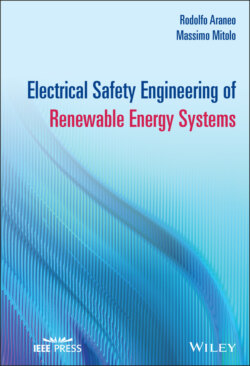Читать книгу Electrical Safety Engineering of Renewable Energy Systems - Rodolfo Araneo - Страница 13
1.2 Electric Shock
ОглавлениеExternal electrical stimuli applied to the human body can prevent operational skeletal and cardiac muscles from properly operating, as well as destroy bodily tissues by thermal shock.[8]
External a.c. currents with frequency ranging from 50 to 100 Hz of magnitude around 10 mA for adult males and 15 mA for adult females, can override the internal electrical signals from the brain controlling the body muscles, render the person unable to “let go” of an energized part and cause painful muscle contractions.
For d.c. currents, thresholds of let-go cannot be positively defined. The circulation of d.c. current through the body only causes a sensation of warmth, and the person is subjected to painful muscle contractions only during making and breaking of the d.c. current.
Stevens’ Law [9, 10] describes the perceived strength of a physical stimulus as a function of its intensity, expressed in its physical units. According to Stevens’ Law, the perception of electric shock is superlinear with the stimulus, as varies as the 3.5 power of the a.c. voltage applied. The coefficient 3.5 relates the magnitude of the applied voltage to the perceived magnitude of the shock as current through the fingers; thus, a small increase in the applied voltage is perceived as a larger increase in the electric shock.
A 30 mA-current, if interrupted within 300 ms, can cause involuntary muscular contractions but usually no harmful electrical physiological effects. Longer disconnection time, up to 5 s, can cause muscular contractions, difficulty in breathing, reversible disturbances of heart function, but usually no organic damage.
Higher body currents inhibit internal muscle control, prejudicing the function of the muscles involved in the breathing process, thus causing asphyxia.
